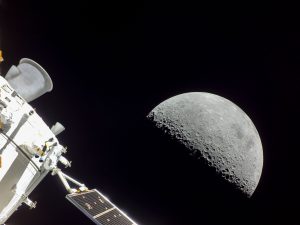
India’s Chandrayaan-3 spacecraft has successfully landed on the Moon, beating Russia’s ill-fated Luna-25 in the race to the lunar south pole, where scientists suspect that water might be found locked away in the region’s rocks, a discovery that may be confirmed by the probe’s lunar rover. This achievement makes India not only the fourth nation to land on the Moon, but also the first to land at the Moon’s south pole.
Chandrayaan-3 (‘Mooncraft-3’ in Sanskrit) launched from the Satish Dhawan Space Centre on July 14, 2023, and has spent the time since performing a series of orbital maneuvers that increased the spacecraft’s altitude until it achieved a trans-lunar injection orbit on August 5. Once in lunar orbit, the craft launched the Vikram (‘Valour’) lander on August 23, of which successfully touched down at 12:34 GMT at a location between the Manzinus and Simpelius craters near the Moon’s south pole. After allowing the dust to settle, a ramp was lowered that allowed the Pragyan (‘Wisdom’) rover to roll out across the powdery regolith.
“India took a walk on the Moon!,” a statement from India’s space agency, the Indian Space Research Organisation (ISRO), said.
“This success belongs to all of humanity and it will help moon missions by other countries in the future,” remarked Prime Minister Narendra Modi said in a speech following Chandrayaan-3’s successful landing. “I’m confident that all countries in the world, including those from the global south, are capable of capturing success. We can all aspire to the moon and beyond.”
Chandrayaan-3 is the third lunar mission launched by the ISRO: Chandrayaan-1 studied the lunar surface from orbit for a little over a year before its systems failed in 2009; Chandrayaan-2, launched in 2019, was intended to land and deploy its own rover on lunar surface, but its Vikram lander crashed after ground control lost contact with the spacecraft, leaving the Chandrayaan-2 orbiter to study the Moon from above.
Chandrayaan-3 was briefly in a race to the lunar south pole with Russia’s Luna 25 lander, launched on August 11 and intended to land near the Boguslawsky crater, also at the Moon’s south pole; however, the lander crashed after a maneuvering engine refused to shut off after moving the craft into a pre-landing orbit on August 19. Russia hasn’t landed a probe on the Moon since 1976’s Luna 24 landed in Mare Crisium.
Joining the small group of countries that have successfully landed spacecraft on the Moon, China landed the Chang’e 3 spacecraft in Sinus Iridum in 2013, and Chang’e 4 became the first spacecraft to soft-land on the Moon’s far side in 2019.
The United States remains the only nation to have successfully landed astronauts on the lunar surface with the Apollo program, culminating in 1972 with the Apollo 17 mission. NASA plans to return to the moon with the manned Artemis 3 mission in 2025.

Subscribers, to watch the subscriber version of the video, first log in then click on Dreamland Subscriber-Only Video Podcast link.
Hmm, underwhelming footage/’proof’, underwhelming reactions from Indian leadership..
You know, this is how fakery conspiracy theories start..lol.
Peace.
For the life of me, I initially thought the flag waving gif was a joke.
As a longtime space nut, I was and am thrilled to see India’s Moon landing and their exploits since then. Today one news organization reported that the Indian lander’s rover came within 10 feet of a deep crater, but Indian scientists saw the danger in time and steered clear, yay.